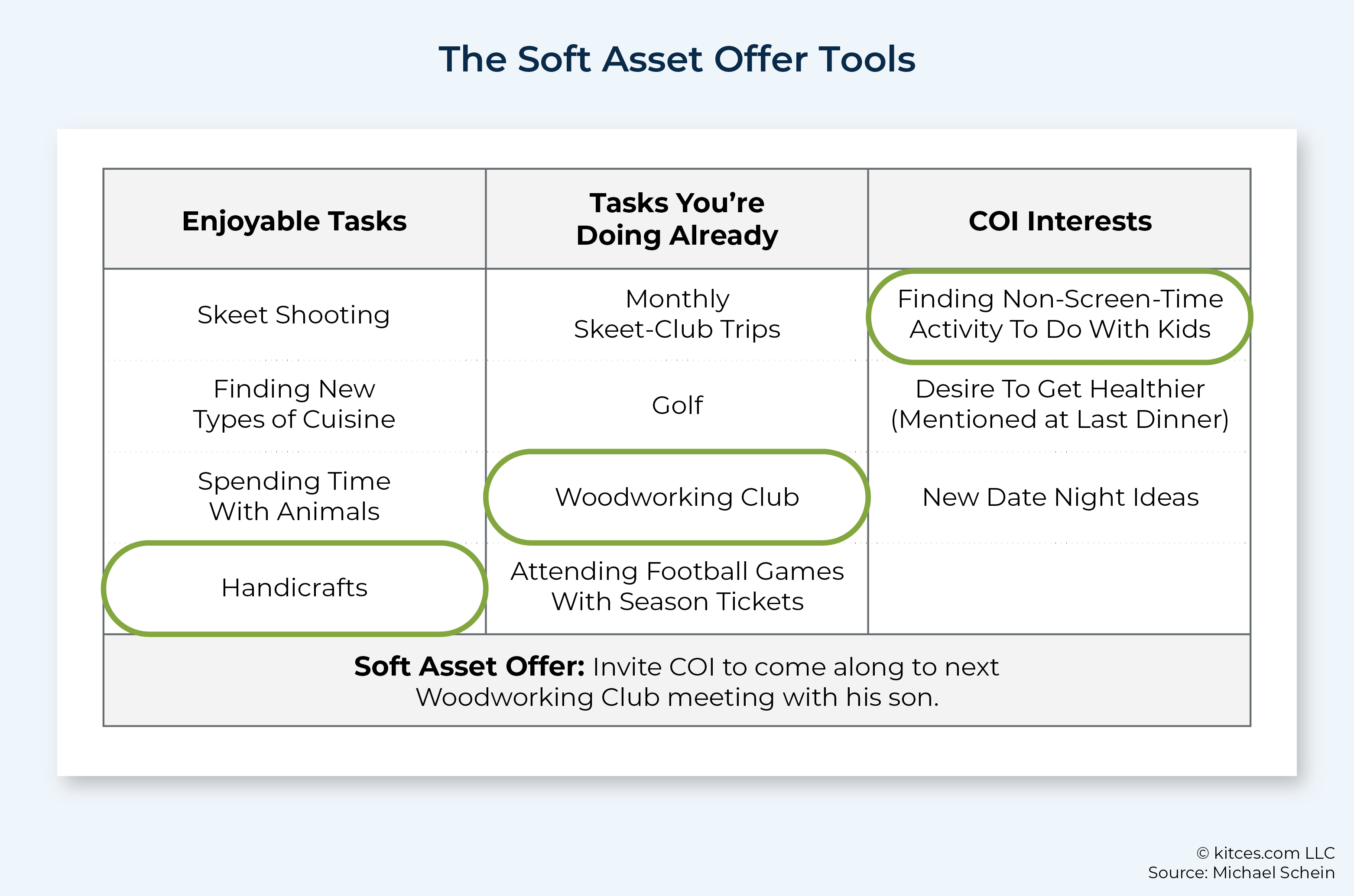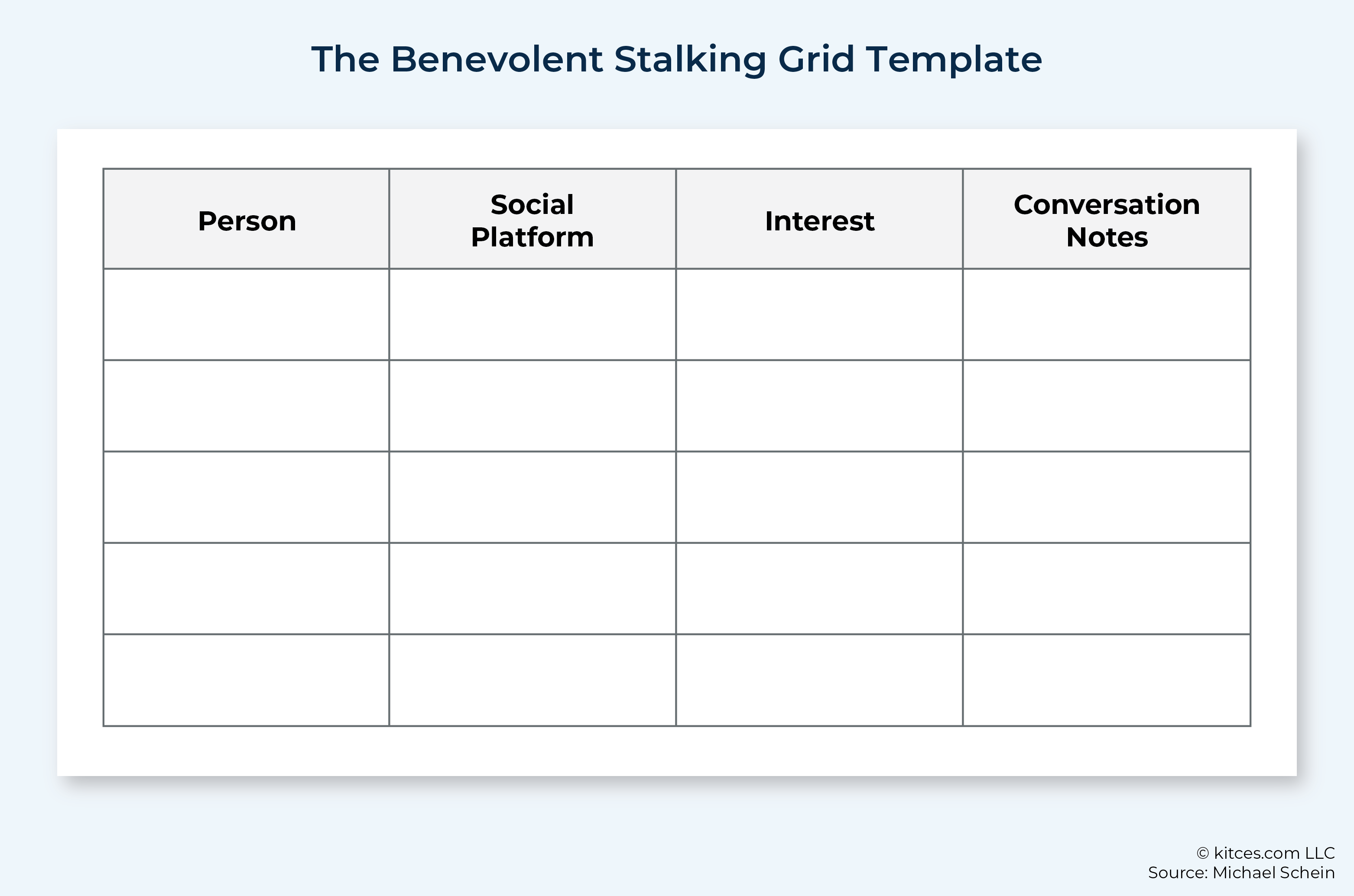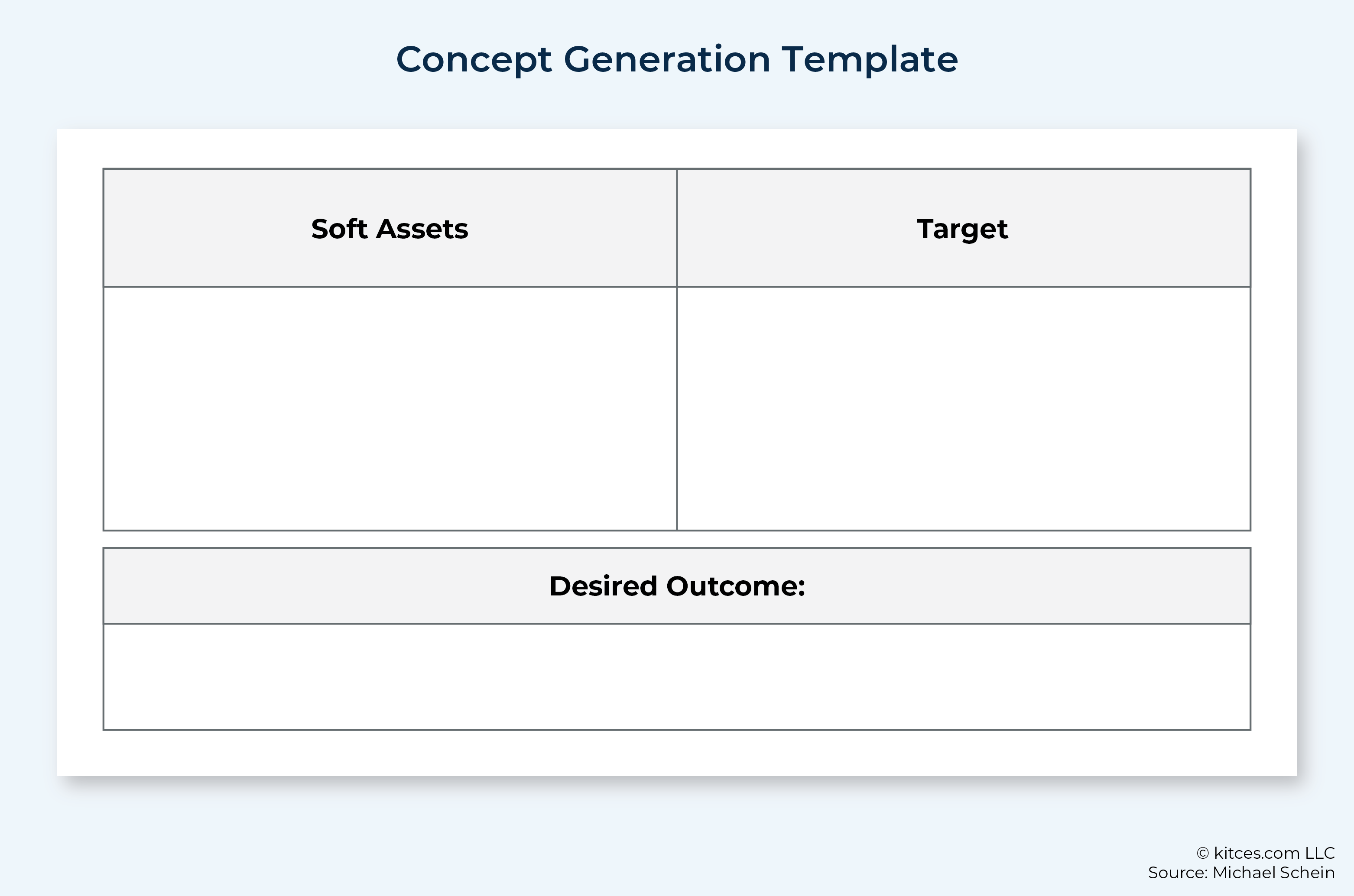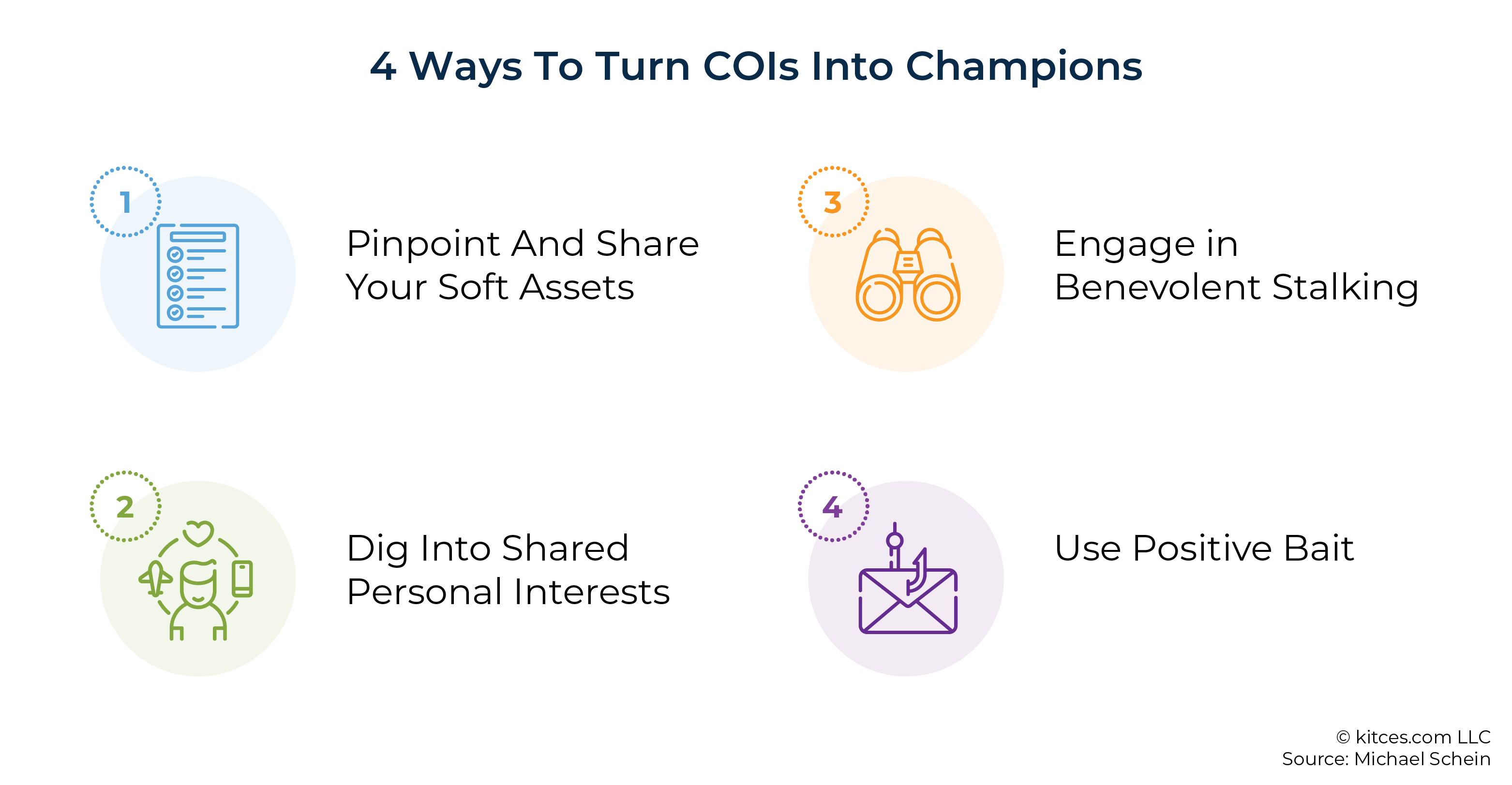Executive Summary
Soliciting prospect referrals can often be an effective way for financial advisors to grow their firms with clients who are ready to act and who will benefit from the firm since many referrals come from sources that are familiar not just with the advisor and the services they offer, but also with the prospect being referred and the needs they seek. This is particularly true when referrals come from Centers of Influence (COIs) – professionals who are trusted by their circles to influence ideal prospects to consider an advisor in the first place. Yet, many advisors might not prioritize networking with COIs or approaching them for client referrals and, as a result, may miss potential opportunities for valuable client referrals.
In this guest post, Michael Schein, founder of MicroFame Media and author of The Hype Handbook, helps advisors recognize how COIs can be powerful referral generators and shares his process of building connections with COIs using the power of their own "soft assets" that help them identify and leverage shared interests and skills not necessarily related to professional achievements.
Soft assets are talents, interests, and skills that are not directly related to one's professional field. They tend to come naturally, are plentiful, and are easy and pleasurable to share with others (such as an enthusiasm for cars, cooking, or closely held values). And the financial advisor who can find an overlap between their soft assets and the interests of a COI they'd like to connect with is much more likely to be successful in their outreach efforts. This is because they demonstrate that they are paying attention and want to 'deposit' something meaningful with the COI, rather than just seeking to 'withdraw' from whatever services the COI may have to offer.
In order to identify a match of soft assets, something as simple as following potential COIs on social media and noting the issues and interests that are shared at any given time can be a great starting point. From there, when the advisor is ready to reach out (whether via email, social media messaging, or something similar), leading with soft assets is key to building common ground. Often, sharing a connection through soft assets can be more valuable than the professional services of the COI – at least at first. Of course, the professional 'ask' can (and should) still be present, but "burying the lede" by placing this ask deeper in the email or message can help advisors establish connection-oriented alliances with these COIs – and from there, unlock the door to long-lasting professional relationships!
Ultimately, the key point is that building connections with COIs can sometimes take time and effort – but when advisors can align overlapping soft assets with a COI and identify shared, more personal common interests, they are far more likely to develop relationships that offer mutually beneficial outcomes. Which means that introspection and awareness of their own personal interests can take advisors a long way to connecting with COIs and new clients – and, in the end, leading to arrangements that benefit everyone!
Relationships are important in every field, but not all fields have an industry-specific term for them. So it is telling that the financial advisory space does. According to Charles Schwab's 2013 white paper, Leveraging Centers Of Influence: Creating A Successful COI Program, a Center Of Influence (COI) is "any professional who is a trusted advisor and who can influence your ideal client to consider hiring you." This simple definition understates how vital COIs are to the success of most financial services professionals. In a recent research study conducted by CEG Insights, upwards of 70% of financial advisors report that their best clients came from an introduction made by a COI.
Even though the importance of Centers of Influence is widely recognized in the financial services space, many advisors struggle to connect with them other than on a transactional basis, which results in only a sporadic and unpredictable trickle of opportunities. That being said, there are other advisors who consistently turn COIs into enthusiastic promoters of their services. These advisors rely on the power of their own soft assets.
Unlike cash, real estate, and office equipment, soft assets are talents, interests, and skills that are not directly related to one's professional field. They come naturally, are plentiful, and are easy and pleasurable to share with others.
In a recent article for CNBC.com, Trey Lockerbie, host of the podcast We Study Billionaires, described 3 traits most wealthy people possess, as gleaned from interviews with 25 billionaires and more than 100 self-made millionaires. Of the 3 traits he covered, the one he highlighted as most important was the tendency to "say 'no' much more than they say 'yes'". Because the Centers of Influence with the most potential to become indispensable to the growth of an advisor's business almost certainly fall into this category, it is important to understand the signals they use to decide which small number of new relationship opportunities they'll say "yes" to out of the many that cross their desks.
The most well-connected COIs have their pick of financial service professionals to refer to their associates, acquaintances, friends, and clients. As such, technical excellence is not enough. In fact, an advisor who overtly tries to demonstrate how good they are at what they do will, ironically, often cause a COI's protective walls to go up. With everyone coming to them all the time for the opportunities they can provide, most high-level COIs train themselves to spot transactional approaches as warning signals.
Fortunately, there is a way around this defensiveness. By focusing first on areas not directly related to what you do for a living, you can get COIs to lower their guard. And by concentrating on the spots where your human interests intersect with theirs, you can even create deep and lasting bonds with COIs.
Pinpointing Your Soft Assets
As in every industry, financial services professionals tend to fall into patterns. This holds true for the methods they tend to use to connect with COIs. Golf trips. Sponsored charity events. Steakhouse dinners. While business can happen through these activities, engaging in them makes it difficult for advisors to set themselves apart. To gain a real advantage, it is useful to look far outside your field for ideas.
The Saxophone Connection – A Journalist's Strategy To Interview David Bowie
In the early '70s, a young music journalist who worked for Musician magazine decided he was going to get an interview with David Bowie. He was new to the game and lacked connections and resources, which made an already difficult task seemingly impossible.
Not only was Bowie one of the biggest stars in the world, but he was also one who guarded his public image the most tightly. Even seasoned reporters would only get to see him for a few minutes and then receive the most surface-level information.
The Musician journalist, however, took a different approach than his more senior competitors. He started by doing research, whereupon he discovered that David Bowie was listed as a saxophone player in the liner notes of all his albums. This struck him as odd because Bowie was not known as a sax player; he was known for his image. He was known for his songs. He was known for his singing. But barely anyone even knew he played the saxophone.
 With a little more digging, the journalist found out not only that Bowie played the saxophone, but also that the sax was his first instrument. He loved the saxophone. Oddly, though, no one ever asked him about it.
With a little more digging, the journalist found out not only that Bowie played the saxophone, but also that the sax was his first instrument. He loved the saxophone. Oddly, though, no one ever asked him about it.
The journalist reached out to Bowie's people, and they almost hung up on him. Before they did, though, he managed to get out that he wanted to interview the star about something not normally covered – his saxophone playing. Bowie's inner circle knew what the sax meant to the star, so they granted the interview. The journalist sat down with Bowie and began the interview by making it all about his favorite instrument. Bowie opened up as he had never done before with any member of the press. Before long, the 2 of them had slid into all kinds of topics well beyond the original subject. The article was published, became a seminal piece of rock journalism, and transformed its writer's career, making him one of the most in-demand rock reporters on the scene.
For the journalist, looking through some record sleeves to uncover Bowie's secret passion and then asking him about it was relatively easy. It most likely didn't take much time and it gave him a good angle for an interview, which he needed anyway. For Bowie, though, the chance to talk about his first musical love was invaluable. It fulfilled a deep need he probably didn't even know he had. The reporter gave a man who could have nearly anything the opportunity to talk about one thing he wouldn't have otherwise been able to. And the story he wrote helped the young journalist to piggyback off of the star's considerable influence to begin building his own.
In short, the journalist leveraged soft assets that were 'cheap' for him but that were disproportionately valuable to his most important Center of Influence. It's a lesson any financial advisor would be wise to heed. What is easy and enjoyable for you to do that will provide immeasurable value to influential people?
How Financial Advisors Can Identify Their Own Soft Assets
"I know an advisor who loves cars," says wealth management advisor Isaac Cohen, Founder and CEO of Bedrock Wealth Strategies. "He would spend all his free time doing car-related things even if he wasn't getting paid. So, he does car events. He sets up these events with the dealerships and invites wealthy people so they can test drive these amazing cars. As you can imagine, the dealerships like it too."
On the other hand, Albert Fox, principal at Fox, Penberthy & Dehn at Morgan Stanley, explains, "I'm a caretaker. That's my natural way of going about my day-to-day life. It just so happens that I camp in an audience that has a lot of needs. So, for example, once in a while someone will say to me, 'I've got 11 years' worth of statements in 4 boxes in the garage. What do you think I should do with them?' I'll say, 'You know what, it would bother me if they were in my garage. Let me send someone there to get rid of them. I'll send someone to pick them up and place them in our locked corporate shredder.'"
The specific soft assets these advisors draw upon are different, but their essence is the same. Soft assets come naturally. They are low-impact. They provide outsized value, which extends beyond the strictly professional.
Because our soft assets, by their very nature, come so naturally to us, we often fail to recognize them. Dan Sullivan and Shannon Waller of The Strategic Coach, one of the largest and oldest business coaching organizations in North America, have created intellectual property that helps financial advisors and other entrepreneurs surmount this blind spot.
A major tenet of The Strategic Coach's program is that the more time entrepreneurs (whom they define as anyone whose compensation comes as a direct result of their performance) spend working in their "Unique Ability", the more success they will have. They have a process that helps the people they work with get clear on what their Unique Abilities are.
Over the course of 1 week in their Signature Program, they ask students to record every activity that fills their days (including weekends). Once this exercise is complete, the students are asked to tag each of the activities based on whether they increase or deplete their energy. Next, they encourage students to send an email to 8 to 10 people – friends, family members, and colleagues – asking them to describe "talents and abilities, characteristics that describe me, what I'm good at, how I do things, what you count on me for, and any other distinguishing features you see about who I am." Based on a combination of the activities they identify as those that give them energy and the traits their friends, coworkers, and loved ones identify as their strong suits, the Strategic Coach team works with class members to craft their own description of their Unique Ability.
Soft assets are closely related to the concept of Unique Ability. However, whereas Strategic Coach's coursework focuses on how these inherent strengths directly impact how an individual performs within their work, soft assets are generally about performing outside work.
In describing how to make this shift, Isaac Cohen advises financial service providers to "list all the things you enjoy doing on the farthest right side of a sheet of paper. In the middle column, list all the things you currently do. In the third column, write the interests of other people…of various COIs." Where they intersect, he says, are a financial service provider's soft assets.
Below is a tool that formalizes the strategy used by advisors like Cohen who are especially skilled at nurturing COI relationships. The items in each column are by no means designed to encompass the entirety of the soft assets the tool's user should offer. However, focusing on activities they are already involved in, and which they are deeply interested in, is a good place to get started.
The Power Of Benevolent Stalking
Financial advisors are continually frustrated by how inefficient their networking efforts are. They attend industry conferences, sponsor golf tournaments, make countless elevator pitches, and spend half their lives in planes and hotel rooms with hopes that one or another of the endless meetings they take will result in an opportunity.
Much of this wasted time and effort comes from the scattershot nature of these outreach efforts. Every meeting, business trip, cold call, and pitch typically happens without a clear path between the event and whether it will result in a connection with a Center of Influence who can generate real opportunities.
Fortunately, there is a secret weapon available to every financial advisor that will let them kick off relationships with the exact COIs they want to get to know. That weapon is social media.
Most advice about social media marketing emphasizes tactics designed to increase exposure, drive traffic, and garner metrics such as impressions, likes, and shares. In the financial services space, the basic premise underlying this guidance is flawed. It emphasizes the attributes of the technology rather than the reason for using it. It focuses on the regularity of posting or how to game a platform's algorithm rather than methods for using these powerful tools to attract the COI relationships that lead to so much business in the industry.
Fortunately, though, there is a different way to use social media that takes advantage of its most powerful inherent attributes. The clue is right there in its name – social media. It is not uncommon for the CEO of a multibillion-dollar company to respond to tweets (or, in more recent parlance, posts) by people they would almost never answer by email, phone, or in-person drop-in (the latter of which may spark a call to security). This is because the entire purpose of social media is to facilitate 2-way interaction between people who don't yet know each other. It's the reason the platforms exist in the first place, and anyone on the platform is on there for that experience. The real challenge is how to turn superficial exchanges with COIs who can be accessed through social media into enduring relationships.
Start by making a list of 100 prominent COIs who could change the course of your career. Make sure they spend considerable time on a social media platform where you spend time as well. Follow them so you can observe them. Then, do just that. Don't comment or chime in yet. For a month, schedule 30 minutes each day to simply watch them.
What you'll find is that most of what your target COIs talk about will be business-related. But sometimes they will mention something personal – a hobby, something they like to do with their free time, an artist they're a fan of, a show they like, a sports team they're into. And every so often, that specific personal interest or passion will intersect with one of yours. By opening a conversation with a COI around a common human interest, advisors can set themselves apart from the general herd clamoring after them for their time, attention, and money. It might be as simple as "Oh, you're a fan of [obscure musical artist/campsite/athletic venue/show]. I've loved them since I [was 10 years old] [discovered them a month ago]."
Although not every COI will answer you, you will eventually start to get hits as long as you make the activity a consistent habit. And the responses you do get will often provide openings for further conversation. Remember, you do not need to connect with and create bonds with every member on your list. Turning even just a handful of these names into actual relationships could completely transform your practice.
Once you've connected around common human interests, it's time to deploy your soft assets. We were all people before we were professionals. And the more successful a professional becomes, the more they want to be seen as the person they have always been. By opening COIs up around these shared interests and then following up with offers of soft assets once you've gotten to know them, you create ironclad bonds that ultimately lead to new business.
A Set Of Relationship-Building Tools
We all know systems are important. Yet, when it comes to building deep human relationships, taking a systematic approach can feel a little unnatural. Push through the feeling. Building and cementing mutually beneficial relationships increase the sum total of value in the industry, and making this happen requires consistent application of the principles we've been discussing.
For a busy professional, consistency requires the use of strong systems backed by solid tools.
What follows are 3 tools that advisors can apply in their efforts to connect with, nurture, and bond with their most important Centers of Influence.
Benevolent Stalking Grid – Identifying Potential COI Relationships
The Benevolent Stalking Grid, shown below, is a simple 4-column table designed to help you keep track of your 100 top COIs as you observe them to uncover common human interests, as discussed below.
How to use the Benevolent Stalking Grid:
Column 1 – Person. Here is where you list the names (along with companies and positions) of the 100 COIs who would have the most impact on your career if you were able to connect and bond with them.
Column 2 – Social Platform. Next to each of the COIs you selected for Column 1, note the corresponding social media platform on which they spend the most time. Completing this column will require you to check on each name individually and add those who actually spend time on social media. If a COI you originally chose is not present on the appropriate platform, substitute the name with another more qualified COI.
Column 3 – Interest. Once you've scheduled your 30-minute daily time blocks over the course of a month, use this column to note the human interests you observe. If it's a human interest that you share with the COI, star or highlight the entry.
Column 4 – Conversation Notes. When you do finally reach out to any of the COIs here based on common interests and/or soft assets, make notes about the main points of the exchanges here.
Positive Bait Email Template
Once you've determined what your soft assets are and you've made initial contact with a COI through social media, you can use the email template below to use your assets as 'positive bait' to inspire the COI to help you further your goals.
Subject Heading:
Would like to [soft asset offer]
Email Body:
Hi [First name of COI],
[Humorous and/or personal connection point: Create rapport by mentioning a personal interest you have in common. Use humor to disarm and connect.]
[Action they took/something you observed about them that made you reach out – never the main ask you are trying to make: Use this space to let the COI know you've been paying attention to the great work they do, without engaging in general flattery. Specific details are key here.]
[Relevant background with counterintuitive elements: There's no need to include a detailed bio here, but it is important to call out those elements of personal background that tie to the reason the email was sent.]
[Invitation to see if they qualify for inclusion in desirable activity: Scarcity creates demand.]
[Social proof: Indicators of credibility go a long way in getting people to listen. This can include other people who have already said yes to the email's offer.]
[Appeal to their higher instincts, if relevant: Even COIs want to feel like good people.]
[Offhand mention of most important ask: If the end goal is a referral or a sale, don't beat people over the head with it. That said, it's okay to subtly plant the idea in order to come back it later.]
[Direct ask to schedule time to talk or meet]
Best,
[Name/signature]
Positive Bait Email Template Case Study
The founders of an early-stage e-commerce startup knew that connections with high-level branding executives would be an ideal source of referrals for them. One founder has family from Ukraine and so had a deep interest in supporting the country's defensive war effort. He sent the above 'positive bait' email to a number of high-level branding agency executives, asking them if they wanted to speak at a digital conference on branding and e-commerce where all the ticket revenue would be donated to the Ukrainian war effort. (Certain identifying details have been obscured for privacy purposes.)
Startup Conference Positive Bait Email
Subject: Would like to feature you at Ukraine event
Hi [XXXX],
Even though you're literally the guy who wrote the book on how to ignore unwanted emails, I heard about your pledge to donate your book royalties to Ukrainian causes and had to get in touch.
I've lived in Ukraine, my wife is Ukrainian, and many of the employees of the 2 companies I co-founded are Ukrainian.
None of those are the reasons I've upended my entire professional life over the past few weeks to help change the tide there.
It's because of my experience as an entrepreneur.
Before this war, Ukraine had been Europe's least likely and most incredible entrepreneurial success story. Companies like [business], [business], and [business] helped turn this former outpost of the Soviet Union into a thriving and growing nation.
As a business owner who has been untouched by the ravages of war, I understand as never before how much I owe my fellow entrepreneurs who have seen their dreams wiped away in one un-asked-for swoop.
I still believe that entrepreneurship is the greatest force for positive change in the world, and I simply can't let a horrible unwanted war destroy that vision.
That's why my partners at [XXXX] and I are organizing and sponsoring the [XXXX] Conference, an event all about empowering entrepreneurship on a global level. Every penny of the proceeds will be donated to the [YYYY] Ukraine relief effort.
[Biggest name], [second biggest name], and [third biggest name] are already on board.
You're on our shortlist to speak at the event as well. It'd be great to schedule 15 minutes sometime next week to talk to see if it's a good fit.
What does your schedule look like next week?
Best,
[Signature Info]
The feeling of being able to contribute to a cause that the target COIs tended to see as important and worthy, at a time when this issue was at the forefront of the news cycle, ensured a very strong affirmative response. As a result, the startup's founder was able to simultaneously meet with these important Centers of Influence, create a lasting impression with them, and also advance a cause he cared deeply about.
Although this case study does not fall in the financial services space, the same principles apply.
Concept Generator
Coming up with creative ideas to transform your COIs into your practice's greatest champions takes a steady stream of creative ideas about how to connect your soft assets to your COIs' needs in service of desired outcomes. If these kinds of ideas don't always come naturally, this tool will help.
To use the Concept Generator Template, shown below, list as many soft assets as you can in the upper left-hand "Soft Assets" box. Then, in the upper right-hand box labeled "Target", write down the COI you have in mind, along with their most pressing needs. Finally, in the bottom "Desired Outcome" rectangle, input the result that would currently make the biggest difference in your business.
Once each box is filled out, set a timer for 5 minutes and write down as many ways you can think of that connecting your soft assets to your COI target needs could lead, indirectly or directly, to the desired outcome.
The idea here is to keep your hand moving across the page or on the keyboard without stopping to think too deeply. In coming up with innovative solutions, quantity begets quantity. Sometimes, from the ideas that seem the silliest, the most workable and game-changing concepts arrive. The most respectable answers are often the ones everyone has already tried, which usually make them the least effective.
4 Ways to Turn COIs Into Champions
- Pinpoint and share your soft assets
- Dig into shared personal interests
- Engage in benevolent stalking
- Use Positive Bait
In an industry where the majority of new business comes through Centers of Influence, creating a robust and predictable system to generate close, mutually beneficial relationships with them on an ongoing basis is essential. Yet, many financial advisors leave these efforts up to chance, relying on a series of general networking and business development activities and essentially crossing their fingers that they will run into and impress COIs who might be able to help them.
Yet, by developing a deeper understanding of the realities of human nature, advisors can eliminate this uncertainty. Like everyone else, even the most prominent Centers of Influence desire appreciation, exposure, and understanding of their non-professional selves. By appealing to these facets first, financial service professionals can regularly take COIs beyond the realm of mere connections and turn them into their everlasting champions.









Leave a Reply